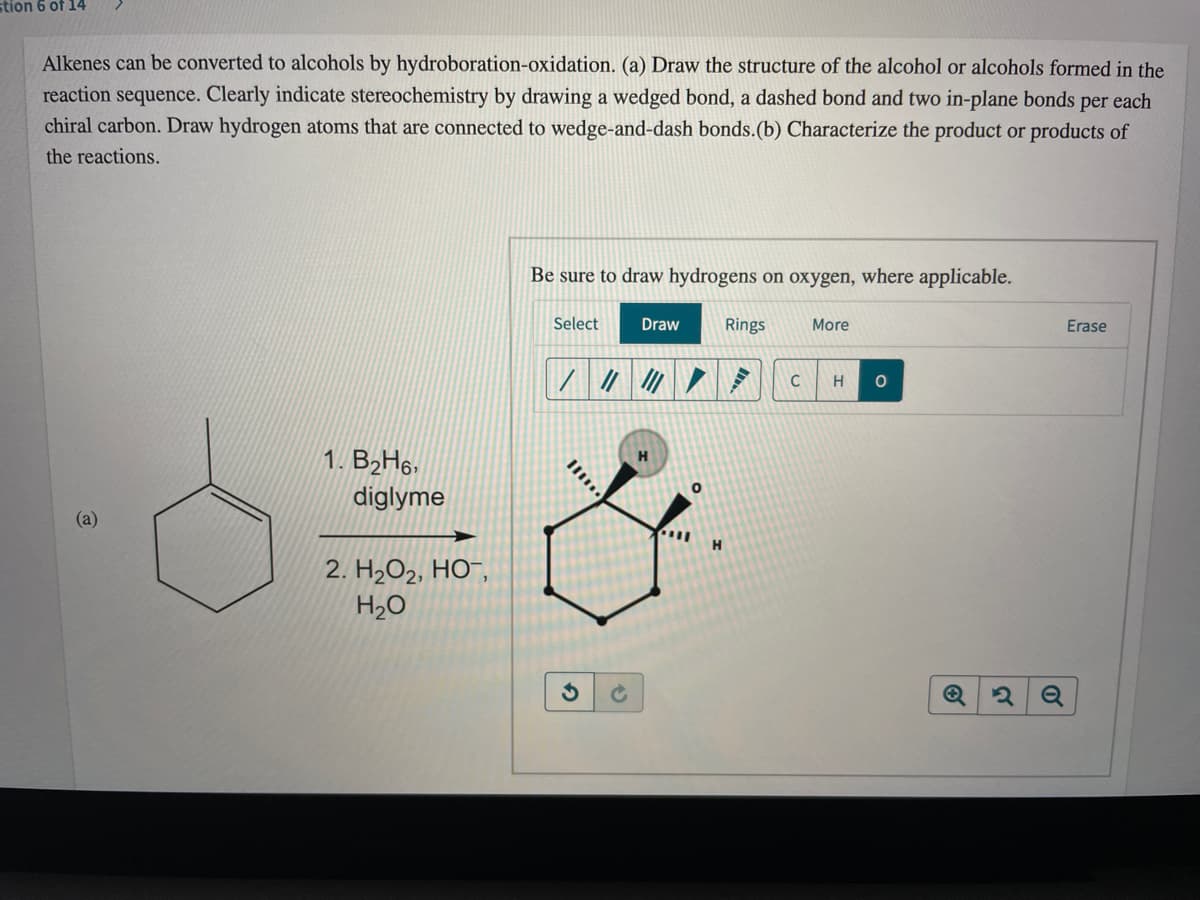Alkenes can be converted to alcohols by hydroboration-oxidation. (a) Draw the structure of the alcohol or alcohols formed in the reaction sequence. Clearly indicate stereochemistry by drawing a wedged bond, a dashed bond and two in-plane bonds per each chiral carbon. Draw hydrogen atoms that are connected to wedge-and-dash bonds.(b) Characterize the product or products of the reactions. Be sure to draw hydrogens on oxygen, where applicable. Select Draw Rings More Erase C 1. B2H6, diglyme (a) 2. НО2, НО-, H2O
Alkenes can be converted to alcohols by hydroboration-oxidation. (a) Draw the structure of the alcohol or alcohols formed in the reaction sequence. Clearly indicate stereochemistry by drawing a wedged bond, a dashed bond and two in-plane bonds per each chiral carbon. Draw hydrogen atoms that are connected to wedge-and-dash bonds.(b) Characterize the product or products of the reactions. Be sure to draw hydrogens on oxygen, where applicable. Select Draw Rings More Erase C 1. B2H6, diglyme (a) 2. НО2, НО-, H2O
Chemistry
10th Edition
ISBN:9781305957404
Author:Steven S. Zumdahl, Susan A. Zumdahl, Donald J. DeCoste
Publisher:Steven S. Zumdahl, Susan A. Zumdahl, Donald J. DeCoste
Chapter1: Chemical Foundations
Section: Chapter Questions
Problem 1RQ: Define and explain the differences between the following terms. a. law and theory b. theory and...
Related questions
Question

Transcribed Image Text:stion 6 of 14
Alkenes can be converted to alcohols by hydroboration-oxidation. (a) Draw the structure of the alcohol or alcohols formed in the
reaction sequence. Clearly indicate stereochemistry by drawing a wedged bond, a dashed bond and two in-plane bonds per each
chiral carbon. Draw hydrogen atoms that are connected to wedge-and-dash bonds.(b) Characterize the product or products of
the reactions.
Be sure to draw hydrogens on oxygen, where applicable.
Select
Draw
Rings
More
Erase
C
1. B2H6.
diglyme
(a)
2. H2O2, HO¯,
H20
Expert Solution
This question has been solved!
Explore an expertly crafted, step-by-step solution for a thorough understanding of key concepts.
This is a popular solution!
Trending now
This is a popular solution!
Step by step
Solved in 2 steps with 1 images

Knowledge Booster
Learn more about
Need a deep-dive on the concept behind this application? Look no further. Learn more about this topic, chemistry and related others by exploring similar questions and additional content below.Recommended textbooks for you

Chemistry
Chemistry
ISBN:
9781305957404
Author:
Steven S. Zumdahl, Susan A. Zumdahl, Donald J. DeCoste
Publisher:
Cengage Learning

Chemistry
Chemistry
ISBN:
9781259911156
Author:
Raymond Chang Dr., Jason Overby Professor
Publisher:
McGraw-Hill Education

Principles of Instrumental Analysis
Chemistry
ISBN:
9781305577213
Author:
Douglas A. Skoog, F. James Holler, Stanley R. Crouch
Publisher:
Cengage Learning

Chemistry
Chemistry
ISBN:
9781305957404
Author:
Steven S. Zumdahl, Susan A. Zumdahl, Donald J. DeCoste
Publisher:
Cengage Learning

Chemistry
Chemistry
ISBN:
9781259911156
Author:
Raymond Chang Dr., Jason Overby Professor
Publisher:
McGraw-Hill Education

Principles of Instrumental Analysis
Chemistry
ISBN:
9781305577213
Author:
Douglas A. Skoog, F. James Holler, Stanley R. Crouch
Publisher:
Cengage Learning

Organic Chemistry
Chemistry
ISBN:
9780078021558
Author:
Janice Gorzynski Smith Dr.
Publisher:
McGraw-Hill Education

Chemistry: Principles and Reactions
Chemistry
ISBN:
9781305079373
Author:
William L. Masterton, Cecile N. Hurley
Publisher:
Cengage Learning

Elementary Principles of Chemical Processes, Bind…
Chemistry
ISBN:
9781118431221
Author:
Richard M. Felder, Ronald W. Rousseau, Lisa G. Bullard
Publisher:
WILEY